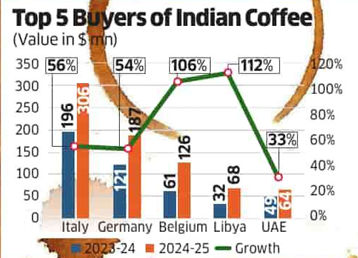Table of Contents
Context: The country’s coffee exports have increased by about 125% to $1.8 billion over the last 11 years, according to government data.
Journey of Coffee Plantation in India
- Origin (17th Century): Introduced around 1670 by Baba Budan, who smuggled seven coffee seeds from Yemen and planted them in the hills of Chikmagalur, Karnataka.
- British Expansion (19th Century): British planters systematically expanded coffee cultivation in Karnataka (especially Kodagu and Chikmagalur), Tamil Nadu (Nilgiris), and Kerala (Wayanad).
- Post-Independence Scenario (1950s-1980s): Coffee plantations gradually expanded to other southern states, stabilising India as a key global exporter.
- Crisis and Transition (1990s): Severe white stem borer infestations destroyed high-quality Arabica coffee plantations, especially in Karnataka.
- Farmers transitioned from Arabica (high-quality, sensitive, premium-priced) to Robusta (hardy, lower-priced).
- Recent Boom (Post-2020): Robusta coffee prices surged globally, driven by global shortages, positioning Indian coffee (especially from Kodagu) favourably in international markets.
- Exports reached record levels ($1.2 billion in FY2024-25), despite modest volume growth.

Major Regions of Coffee Plantation in India
- Karnataka (Largest producer ~70% of India’s coffee):
- Kodagu (Coorg): Robusta-dominated, largest contributor.
- Chikmagalur: Traditionally Arabica-dominant but increasingly shifting to Robusta.
- Hassan: Mixed Arabica and Robusta.
- Kerala: Wayanad (Predominantly Robusta).
- Tamil Nadu: Nilgiris, Yercaud, Shevaroys, Palani Hills (Mostly Arabica).
- Andhra Pradesh: Araku Valley High-quality, exclusively Arabica.
- Northeast India: Parts of Assam, Meghalaya, Mizoram, Tripura, Nagaland.
Requirements for Coffee Plantation
- Climate:
- Moderate rainfall (150–250 cm/year).
- Cool to moderate temperatures (15–28°C).
- Frost-free environment.
- High humidity and misty conditions are ideal.
- Altitude:
- Arabica: Higher altitudes (600–2200 meters above sea level).
- Robusta: Lower elevations (300–800 meters above sea level).
- Soil: Rich, well-drained loamy soils with organic matter.
- Slightly acidic (pH around 6.0 to 6.5).
- Shade & Canopy: Indian coffee is predominantly grown under shade (shade-grown), creating a natural habitat that preserves biodiversity and moisture.
- Trees such as Jackfruit, Silver Oak, Teak, and Pepper vines are common shade-providers.
- Labour Intensive:
- Primarily hand-picked, ensuring higher quality.
- Labour cost is a significant portion (~60%) of production expenses.
Recent Trends and Challenges
- Shifts in Coffee Varieties: Once 70% Arabica and 30% Robusta, the ratio has reversed. Now India exports premium-quality Robusta globally.
- Labour Shortage: High wages, welfare schemes, and urban migration are causing persistent labour shortages.
- Environmental Concerns & Sustainability: Elephant-human conflicts due to plantation encroachment on elephant corridors.
- Indian coffee cultivation’s shade-grown method positions India advantageously under new EU deforestation regulations (EUDR, effective Dec 2025).
- Market Volatility: Recent price fluctuations due to changing global supplies.
- Increasing the formation of farmer-producer companies to leverage better pricing power.
| Coffee Board of India |
|
Conclusion
India’s coffee industry has traversed multiple phases—from the initial high-value Arabica dominance, through pest-driven challenges, to successfully leveraging robusta’s global demand surge. Strategic interventions by the Coffee Board, sustainability initiatives, and adaptability to global market changes hold promise, though labour availability remains a critical issue moving forward.


 Out-of-Pocket Health Expenditure, Reason...
Out-of-Pocket Health Expenditure, Reason...
 Treasury Bills (T-bills): RBI Cuts Holdi...
Treasury Bills (T-bills): RBI Cuts Holdi...
 Fisheries Sector in India, Current Statu...
Fisheries Sector in India, Current Statu...

























